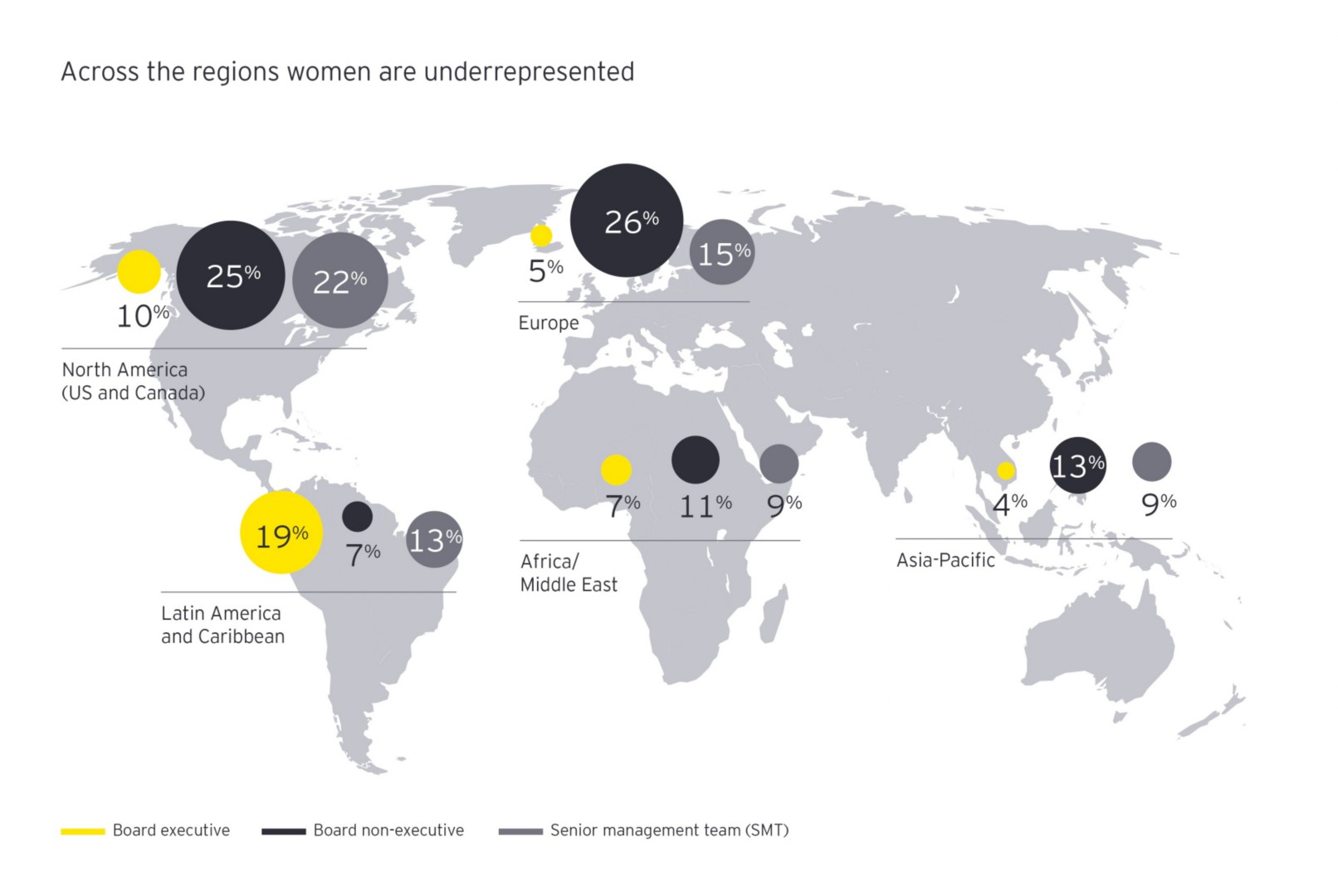
Chapter 1
Diversity is critical to navigating disruption
Utilities that embrace gender diversity can fast-track their innovation.
Since 2014, we’ve highlighted the urgent need to get more women into the most senior roles at utilities through the EY Women in Power and Utilities Index. Of course, diversity goes far beyond gender, but since women make up roughly 50% of the potential workforce, the impact that improving gender equality will make is immense.
But five years after our first set of findings the figures remain disappointingly low.
- 17% of total board members are women — up 2% from 2014.
- 21% of non-executive board members are women — up 3% from 2014.
- 6% of executive board members are women — up 2% from 2014.
- 15% of senior management team members are women — up 3% from 2014.
Top utilities in terms of diversity scores
| Rank | Company name | Country/region | Score |
| 1 | Statkraft | Norway | 3.47 |
| 2 | ENGIE | France | 3.34 |
| 3 | Sempra Energy | United States | 3.33 |
| 4 | Duke Energy Corporation | United States | 2.73 |
| 5 | Hydro-Quebec | Canada | 2.47 |
| 5 | CMS Energy Corp. | United States | 2.47 |
| 7 | SSE plc | United Kingdom | 2.40 |
| 8 | EnergyAustralia | Australia | 2.27 |
| 9 | National Grid plc | United Kingdom | 2.20 |
| 10 | Stedin Holding | Netherlands | 2.13 |
| 11 | Ørsted A/S | Denmark | 1.87 |
| 12 | MDU Resources Group | United States | 1.73 |
| 12 | YTL Corporation Berhad | Malaysia | 1.73 |
| 14 | American Electric Power Co. | United States | 1.67 |
| 15 | China Resources Power Holdings Co. | Hong Kong | 1.53 |
| 16 | Eskom Holdings | South Africa | 1.47 |
| 16 | Hera S.p.A. | Italy | 1.47 |
| 16 | Fortum Oyj | Finland | 1.47 |
| 19 | Edison International | United States | 1.40 |
| 20 | Neoenergia | Brazil | 1.40 |
| 20 | PG&E Corp. | United States | 1.40 |
| 20 | Empresas Públicas de Medellín | Colombia | 1.40 |

The index results show that, even as transformation drives the need to do things differently, few utilities are hearing diverse perspectives at the leadership level. And while research has already proven that a lack of gender equality puts utilities at a distinct disadvantage — boards with at least 30% women have higher profit margins than those who don’t — we now see increasing evidence linking diversity to innovation, which is critical to successfully navigating disruption in this transformation age.
Imagine if utilities could meet exponential disruption with exponential inclusion? Providing equitable opportunities to the right talent could further drive innovation and deliver value quicker to customers.
Is accelerating gender equality the catalyst to accelerating innovation in utilities? Research suggests it is. A study by the Center for Talent Innovation found that companies with diversity are 70% more likely to capture new markets and 75% more likely to get innovative ideas to market. Evidence also suggests diversity leads to improved outcomes – research by Cloverpop found that teams with diversity (including age, gender and geography) make better decisions 87% of the time.
Diversity and new markets
70%Companies with diversity are 70% more likely to capture new markets.
Diversity and innovation
75%Companies with diversity are 75% more likely to get innovative ideas to market.

Chapter 2
Seizing the upsize — now is the time for diversity and innovation
Energy transformation demands fresh thinking and new approaches.
The gender-equality gap at utilities is challenging — but it also represents an enormous opportunity. If utilities can improve their gender equality, even incrementally, evidence suggests they will also boost their innovation quotient. And those utilities that are prioritizing improving gender equality say they already see benefits in three key areas that underpin innovation.
1. Applying different perspectives to unlock better solutions
People with diverse backgrounds not only bring different approaches to problem-solving; they also encourage other team members to recognize and value this diversity of perspectives. This can disrupt “groupthink” and challenge teams to develop fresh solutions to difficult problems.
2. Adapting to change and moving with agility
Navigating disruption successfully requires utilities to move far more quickly than they have in the past. Teams that are more diverse make decisions twice as fast as others — and with half the meetings.
3. Finding — and keeping — the best talent
Utilities face both an exodus of older workers and an urgent need to attract new employees with the creative, technology and customer skills needed to build the utility of the future. Tapping into more women can fill these gaps and also help create an environment that attracts top talent. Companies that frequently rank well in indexes of the world’s best places to work share a commitment to diversity and supporting work-family balance.
“Instead of being discouraged by our index results, I challenge utilities to apply relentless attention to improving them,” comments Cyntressa. “Let’s make 2019 the year that, as an industry and as individuals, we take action that builds more diverse teams and boosts the innovation needed to succeed in this transformative age.”
Instead of being discouraged by our index results, I challenge utilities to apply relentless attention to improving them.
Each utility will need to form its own diversity action plan. Developing yours starts with acknowledging where problems lie. Where’s your particular diversity roadblock? Common issues for your organization to consider are:
Poor representation of women at leadership levels
- How many female leaders do you have? Is this figure improving over time?
- How do you compare to the top utilities in the index?
- Are any key operational roles held by women?
Trouble retaining and nurturing women to leadership
- Do you know how many women leave your company as their career progresses — and why?
- What is your strategy to identify, nurture and advance potential female leaders?
Fragmented and less-impactful diversity initiatives
- Are you still expecting gender equality to improve in your organization organically?
- Do you have a strategy that includes formal programs and multilevel initiatives to attract, retain and promote women? Are these backed by appropriate resources and measured with metrics?
- What mentoring and sponsorship programs do you have in place?
Lack of strong leadership championing diversity
- Is gender equality a board priority?
- What is your target for women in leadership roles — and how is your current leadership supporting this goal?
- Are your leaders mentoring or sponsoring promising women?
- How are you engaging men on this journey? Are you leveraging men as sponsors, mentors and advocates?
It can take time to see the benefits of change within an organization, but each one of us can change our own actions today to make an impact immediately.
Once your organization has recognized its challenges, work can begin to find solutions and reap the proven innovation benefits of a more gender-equal leadership team. Cyntressa emphasizes the importance of personal commitment, as well as industry and company initiatives.
“It can take time to see the benefits of change within an organization, but the good news is that each one of us can change our own actions today to make a tangible impact immediately.” One inclusiveness checklist that Cyntressa recommends can help us all review our behavior:
- Do I actively seek and involve different views by bringing people together with different backgrounds and capabilities?
- How do I choose who to mentor? Am I sponsoring anyone who looks and thinks differently than I do?
- Do I recognize and reward those who demonstrate inclusive behaviors in addition to technical skills? And do I coach and support those who do not demonstrate inclusive behaviors?
- To whom am I giving the harshest feedback? Is their performance truly lacking or are they approaching things differently than I might, yet achieving positive outcomes?
- How do I adapt my behavior to varied styles as well as enable my team to better connect with people and clients who are different?
- Do I make it easy for people to discuss flexible working arrangements? Are people able, and trusted, to apply this arrangement?
Wherever you are on your diversity journey, the potential to improve is in your hands. It’s time to make your move.
Summary
Energy sector organizations that improve gender equality can boost innovation as they prepare for transformative change.
